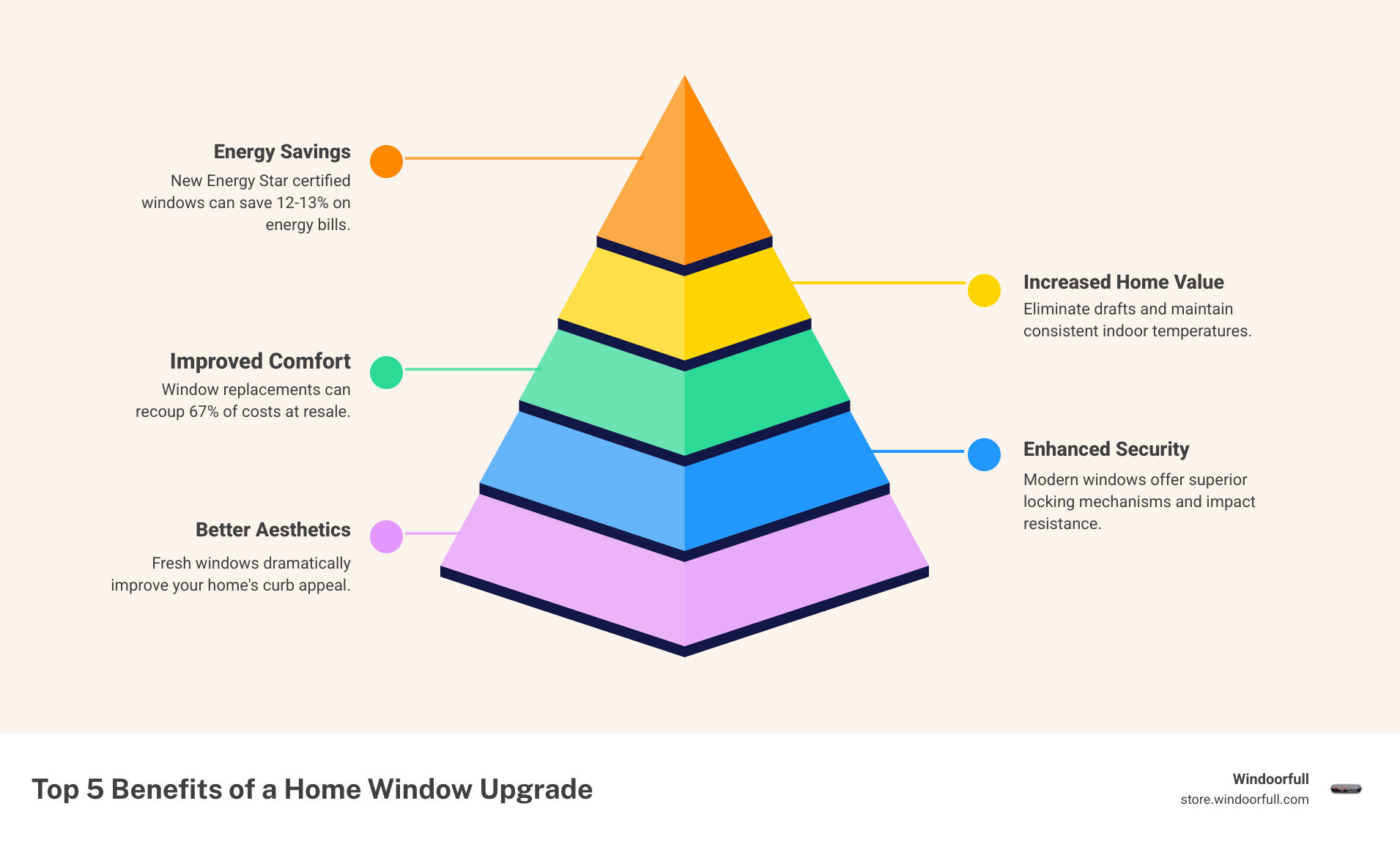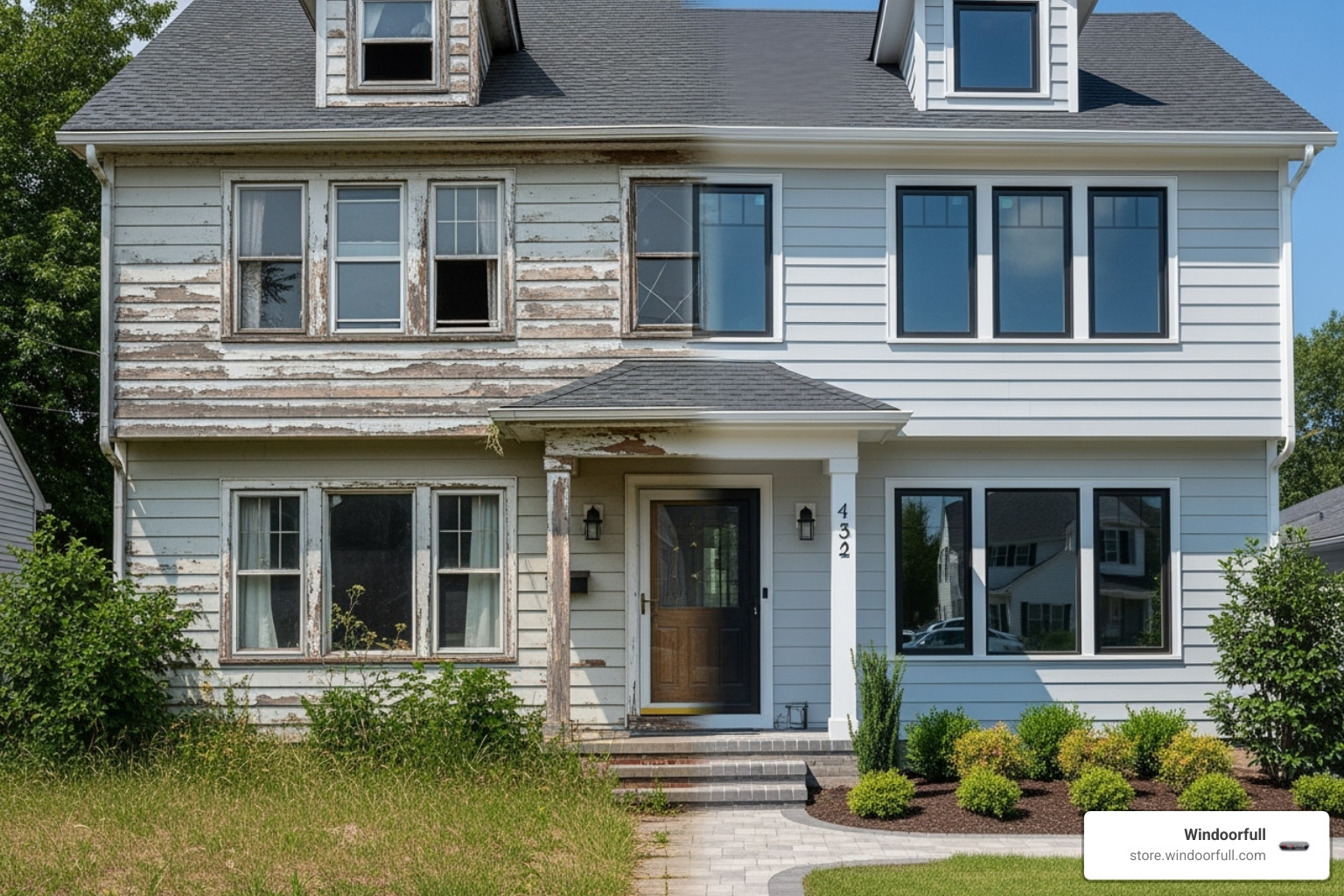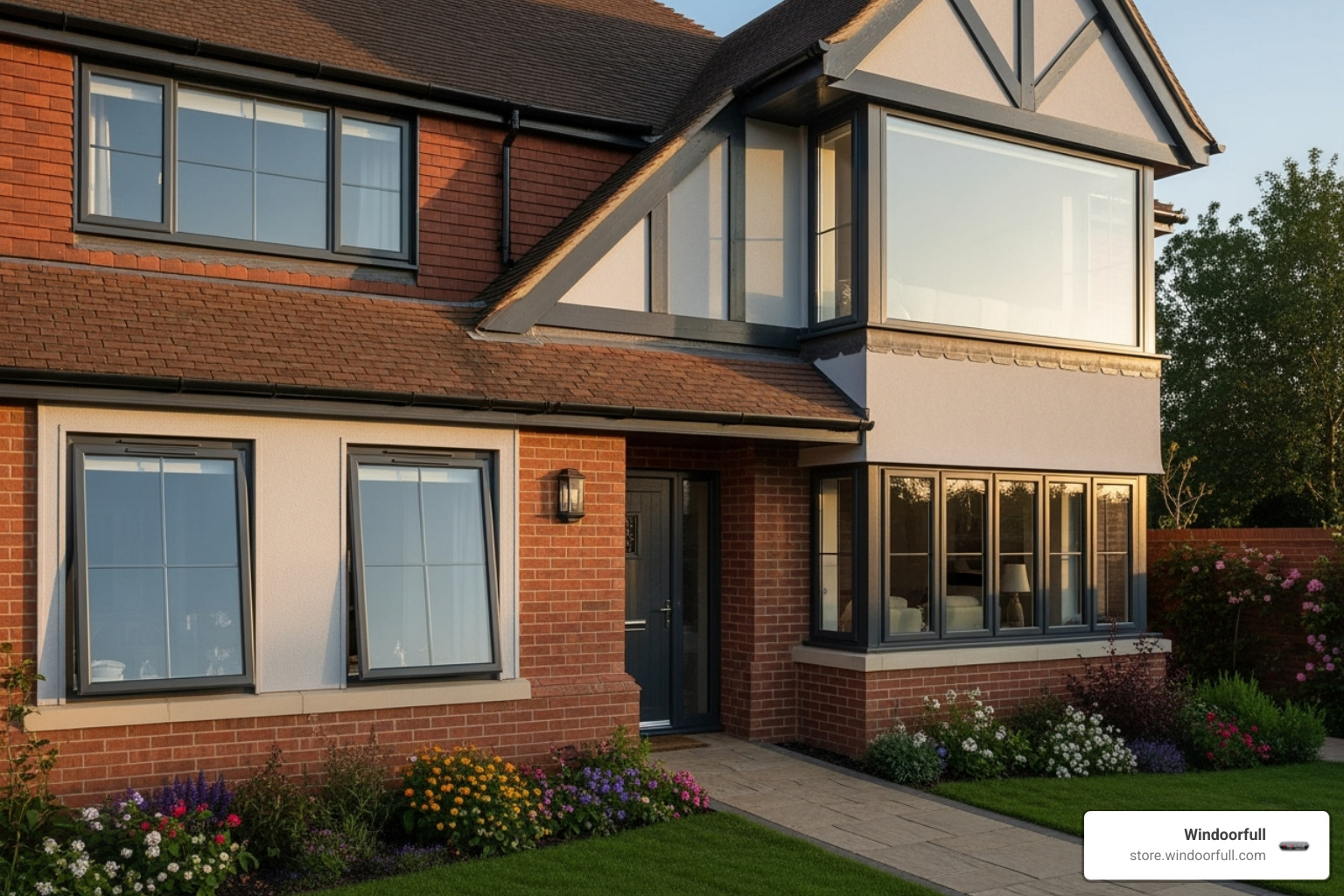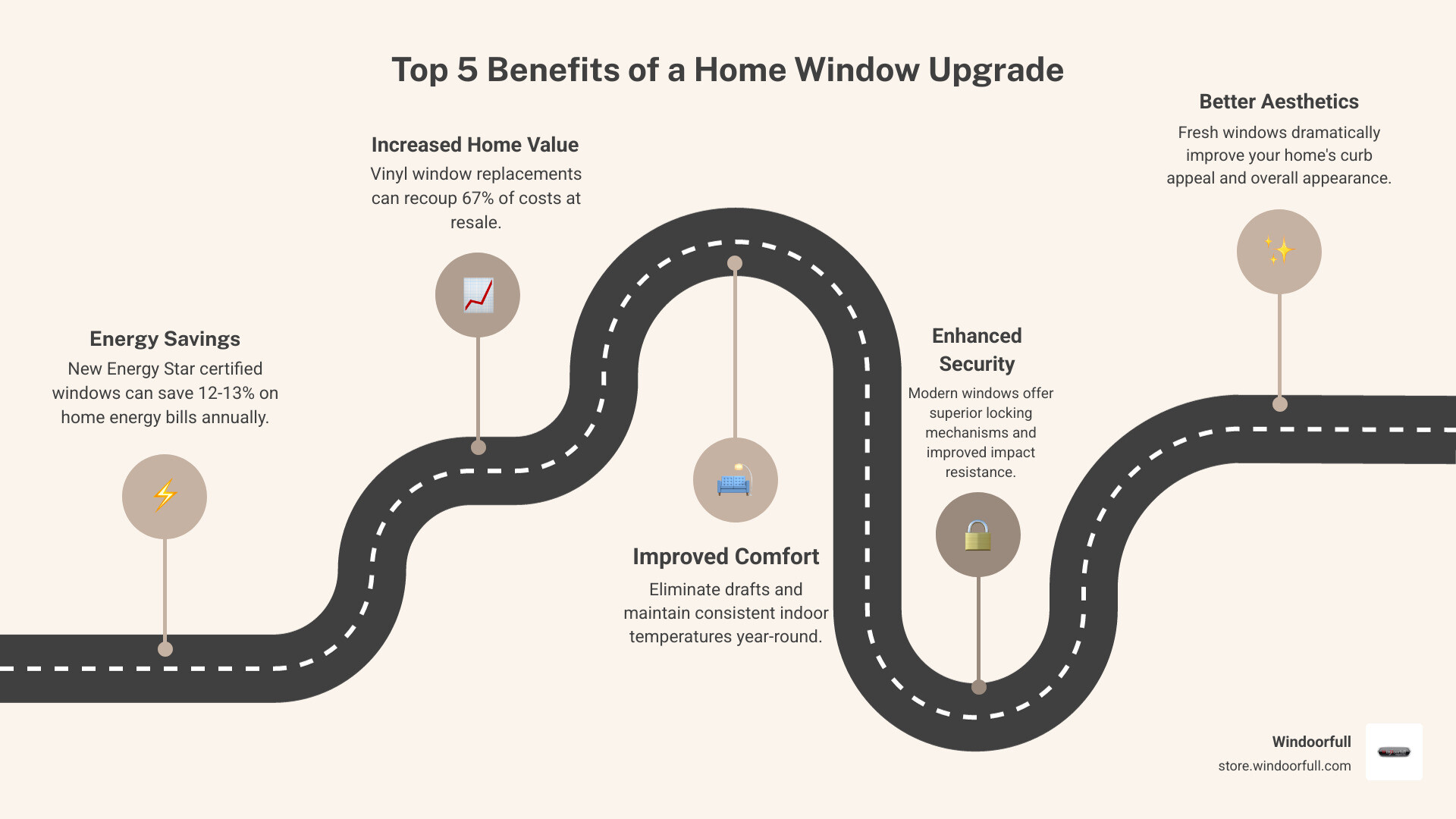
See Clearly Now: The Ultimate Guide to Home Window Upgrades
Share
Why Your Home Desperately Needs a Window Upgrade
Home window upgrade projects can transform your property from an energy-wasting liability into a comfortable, efficient haven. If you're experiencing high energy bills, drafty rooms, or simply want to modernize your home's appearance, upgrading your windows delivers multiple benefits that pay dividends for years to come.
Quick Answer for Home Window Upgrade Seekers:
- Energy Savings: New Energy Star certified windows can save 12-13% on home energy bills
- Increased Home Value: Vinyl window replacements recoup 67% of costs at resale
- Improved Comfort: Eliminate drafts and maintain consistent indoor temperatures
- Improved Security: Modern windows offer superior locking mechanisms and impact resistance
- Better Aesthetics: Fresh windows dramatically improve your home's curb appeal
The numbers tell a compelling story. Replacing 10 inefficient single-pane windows with Energy Star models could save Northern Zone homeowners an average of $568 annually in heating and cooling costs. Meanwhile, approximately 35% of heat loss escapes through walls and gaps around windows and doors, making window upgrades one of the most impactful home improvements you can make.
Whether you're dealing with condensation between glass panes, struggling with windows that won't open properly, or simply tired of watching your energy dollars literally fly out the window, the solution lies in choosing the right replacement windows for your specific needs.
We've spent years helping homeowners steer the complexities of home window upgrade projects through my work at Windoorfull Imports Inc., specializing in premium European-style uPVC windows with tilt-and-turn functionality. My experience has taught me that the right windows don't just improve your home's performance—they transform how you live in your space.

Home window upgrade terms made easy:
Why a Home Window Upgrade is a Smart Investment
Think of your windows as the home window upgrade that keeps on giving. When you invest in new windows, you're not just buying a product—you're investing in years of comfort, savings, and peace of mind. The benefits ripple through every aspect of your home life, from your monthly budget to your daily comfort.
Energy savings represent the most compelling reason homeowners choose to upgrade. Those old windows might look fine, but they're secretly draining your wallet every month. Modern Energy Star certified windows can slash your home energy bills by 12 to 13 percent. For homeowners in colder Northern Zone climates, replacing just 10 inefficient single-pane windows could save an average of $568 annually in heating and cooling costs. Even upgrading from older double-pane windows to new Energy Star models delivers meaningful savings of around $282 per year. These savings compound over time, essentially paying for your investment while you enjoy a more comfortable home.
Your increased home value becomes immediately apparent the moment new windows are installed. According to 2024 estimates from the Journal of Light Construction's Cost vs. Value report, vinyl window replacements recoup about 67 percent of their cost when you sell your home. Wood windows recover 63 percent of their investment. This means your home window upgrade isn't just an expense—it's a strategic investment that follows you to your next home.
Improved comfort transforms how you experience your living space. No more shivering near drafty windows in winter or feeling like you're sitting in a greenhouse during summer. Modern windows create a consistent, comfortable environment by eliminating those annoying hot and cold spots. The improved insulation means your home feels cozy year-round, and the improved natural light can genuinely boost your mood and energy levels.
Improved security gives you something priceless: peace of mind. Today's windows feature advanced locking mechanisms and reinforced frames that make forced entry significantly more difficult. Many options include tempered or laminated glass that won't shatter easily. You can learn more about creating a safer home environment through thoughtful upgrades.
Noise reduction capabilities of modern windows, especially those with double or triple glazing, create a sanctuary from the outside world. Whether it's traffic, neighbors, or general city sounds, quality windows act as an effective sound barrier. The difference is remarkable—you'll actually notice how much quieter your home becomes.
Better curb appeal provides instant gratification. New windows completely transform your home's appearance, making it look fresh, updated, and well-maintained. The visual impact is so significant that neighbors often comment on the improvement immediately.

Signs It's Time for a Replacement
Your windows have a way of telling you when they're ready for retirement. Learning to recognize these signals can save you money and prevent bigger problems down the road.
Drafts are probably the most obvious red flag. If you feel cold air sneaking in during winter or warm air during summer, your windows have lost their battle against the elements. This means your heating and cooling system works overtime, driving up energy bills unnecessarily.
Condensation between panes signals a failed seal in double or triple-glazed windows. Once moisture gets trapped between glass layers, the insulating gas escapes and energy efficiency plummets. Unfortunately, this problem only gets worse over time.
High utility bills often point directly to inefficient windows. If your energy costs keep climbing despite unchanged usage habits, your windows might be the culprit. About 35 percent of heat loss escapes through walls and gaps around windows and doors, making them a prime suspect.
Difficulty opening or closing windows creates both inconvenience and safety concerns. Windows that stick, won't stay open, or require excessive force indicate frame or hardware problems. In an emergency, you need windows that open easily and reliably.
Water damage around window frames or sills demands immediate attention. Stains, rot, or mold indicate water infiltration that can lead to serious structural problems. What starts as a small leak can become a major headache if ignored.
Rotting frames, particularly common with older wood windows, compromise both appearance and function. Warped, swollen, or deteriorating frames can't provide proper seals or support.
Audible outside noise suggests your windows aren't doing their job as sound barriers. Quality windows should significantly reduce external noise, creating a peaceful indoor environment.
Windows older than 15-20 years might still look decent but likely fall short of modern efficiency standards. Even well-maintained older windows can't match today's energy performance, costing you money every month.
Calculating the Return on Your Investment
A home window upgrade delivers returns that extend far beyond the initial purchase price. Understanding these financial benefits helps put the investment in perspective.
Recouping costs at resale provides immediate value when you sell your home. Quality windows appeal to buyers who recognize the long-term benefits of energy efficiency and modern functionality. This makes window replacement one of the more financially sound home improvements.
Strong ROI for quality window upgrades comes from choosing windows that deliver superior performance. Premium windows with excellent energy efficiency ratings not only save more on utility bills but also attract discerning buyers who appreciate quality construction and engineering.
Long-term energy bill reduction represents where your investment truly pays off. Energy-efficient windows can reduce annual energy costs by $125 to $340, according to Energy Star data. Over a window's typical 20-40 year lifespan, these savings often exceed the original investment cost. You can find additional simple steps to reduce your energy bills and see how new windows fit into a comprehensive efficiency strategy.
The math is compelling: quality windows pay for themselves through energy savings while providing decades of improved comfort, security, and aesthetic appeal. When you factor in the increased home value and the intangible benefits of a more comfortable living environment, window replacement becomes one of the smartest investments you can make in your home.
Decoding Your Options: Window Types and Materials
Choosing the right windows for your home window upgrade can feel overwhelming with so many options available. The key is understanding how different window types and materials work together to create the perfect balance of functionality, beauty, and performance for your specific needs.

Think about how each window will function in its designated space. A kitchen window needs easy operation for ventilation while cooking, while a living room picture window might prioritize maximizing natural light and views. Your home window upgrade should improve both the aesthetic appeal of each room and your home's overall architectural style.
A Guide to Window Frame Materials
The frame material you choose will determine how your windows perform for decades to come. It affects everything from your energy bills to how much time you'll spend on maintenance. At Windoorfull, we specialize in premium uPVC windows that bring authentic European engineering to American homes at prices that make sense.
uPVC (Vinyl) windows offer exceptional value and performance. These frames resist warping, rotting, and fading, making them virtually maintenance-free. The multi-chamber design provides superior insulation, helping keep your energy costs down year after year. uPVC windows can last 20-40 years with minimal upkeep - no painting, staining, or sealing required. They're also highly customizable, available in various colors and finishes to match your home's style. You can find more about the magic of Aluplast uPVC and why it's become such a popular choice for modern homeowners.
Wood frames offer timeless beauty and natural insulation properties. They can last 30+ years when properly maintained, but require regular painting or staining to protect against moisture and UV damage. Wood frames typically cost more upfront and demand ongoing maintenance investment.
Aluminum-clad uPVC combines the best of both worlds - the low-maintenance benefits of uPVC with improved durability. The aluminum exterior provides extra protection against harsh weather while maintaining the energy efficiency of uPVC construction.
When comparing materials, consider your budget, maintenance preferences, and local climate. uPVC consistently delivers the best balance of performance, longevity, and value for most homeowners.
Choosing the Right Window Style
Different window styles serve different purposes, and the right choice depends on your specific needs for ventilation, security, and ease of use.
Tilt and turn windows are incredibly versatile, offering two opening modes in one window. The tilt function provides secure ventilation - perfect for upper floors or when you're away from home. The turn function opens the entire window inward for easy cleaning and maximum airflow. These European-style windows also provide exceptional security with multi-point locking systems.
Casement windows hinge on one side and open outward, creating a clear opening for maximum ventilation. They seal tightly when closed, making them very energy efficient. However, they can be challenging to clean from inside upper floors.
Awning windows hinge at the top and open outward from the bottom. They're excellent for ventilation even during light rain, making them popular for bathrooms and basements.
Sliding windows move horizontally and are easy to operate. They work well in areas where you don't want windows protruding outside, though only half the window can be open at any time.
Picture windows don't open but maximize views and natural light. They're often combined with operable windows to create stunning wall compositions.
Bay and bow windows extend outward from your home, creating interior space while adding architectural interest and extra natural light.
The choice often comes down to your priorities. If you want the ultimate in versatility and security, tilt and turn windows often win over casement styles. For those comparing traditional American styles with European innovations, our guide on choosing between tilt and turn or double hung windows can help clarify the differences.
Your home window upgrade should reflect how you actually live in your space. Consider factors like ease of cleaning, security needs, ventilation preferences, and the architectural style of your home when making your final decision.
Why Your Home Desperately Needs a Window Upgrade
Home window upgrade projects can transform your property from an energy-wasting liability into a comfortable, efficient haven. If you're experiencing high energy bills, drafty rooms, or simply want to modernize your home's appearance, upgrading your windows delivers multiple benefits that pay dividends for years to come.
Quick Answer for Home Window Upgrade Seekers:
- Energy Savings: New Energy Star certified windows can save 12-13% on home energy bills
- Increased Home Value: Vinyl window replacements recoup 67% of costs at resale
- Improved Comfort: Eliminate drafts and maintain consistent indoor temperatures
- Improved Security: Modern windows offer superior locking mechanisms and impact resistance
- Better Aesthetics: Fresh windows dramatically improve your home's curb appeal
The numbers tell a compelling story. Replacing 10 inefficient single-pane windows with Energy Star models could save Northern Zone homeowners an average of $568 annually in heating and cooling costs. Meanwhile, approximately 35% of heat loss escapes through walls and gaps around windows and doors, making window upgrades one of the most impactful home improvements you can make.
Whether you're dealing with condensation between glass panes, struggling with windows that won't open properly, or simply tired of watching your energy dollars literally fly out the window, the solution lies in choosing the right replacement windows for your specific needs.
We've spent years helping homeowners steer the complexities of home window upgrade projects through my work at Windoorfull Imports Inc., specializing in premium European-style uPVC windows with tilt-and-turn functionality. My experience has taught me that the right windows don't just improve your home's performance—they transform how you live in your space.

Home window upgrade terms made easy:
Why a Home Window Upgrade is a Smart Investment
A home window upgrade is more than just a renovation; it's a strategic investment in your property and your quality of life. The benefits extend far beyond just looking good, impacting everything from your monthly budget to your daily comfort.
Let's explore the main benefits:
- Energy Savings: This is often the biggest motivator for homeowners. Old, inefficient windows are notorious for letting heated or cooled air escape, forcing your HVAC system to work overtime. Modern, energy-efficient windows, especially those with advanced glazing and frames, significantly reduce heat transfer. In fact, installing new Energy Star certified windows can save the average homeowner 12 to 13 percent on their home energy bills. For those in colder climates, replacing 10 inefficient single-pane windows with new Energy Star models could save homeowners an average of $568 a year in heating and cooling costs in the Northern Zone of the U.S. Even replacing double-pane windows with Energy Star models in the Northern Zone can lead to average savings of $282, or 6 percent, annually. These savings add up over time, helping to offset the initial investment. You can find more energy savings data from ENERGY STAR.
- Increased Home Value: Windows are a significant visual component of your home's exterior and interior. Upgraded windows instantly boost your property’s curb appeal, making a strong first impression on potential buyers. According to 2024 national estimates by the Journal of Light Construction, a vinyl window replacement job sees about 67 percent of its cost recouped in the selling price of a home. For new wood windows, 63 percent of the cost is recouped. This means a significant portion of your investment can be recovered when you decide to sell.
- Improved Comfort: Are you tired of feeling chilly drafts near your windows in winter or experiencing excessive heat gain in summer? Old windows often have poor seals or single panes that offer little insulation. A home window upgrade eliminates these discomforts by creating a tighter, more insulated building envelope. This means more consistent indoor temperatures, fewer drafts, and a cozier living environment year-round. Modern windows also invite more natural light, which can lift your mood and boost productivity.
- Improved Security: Older windows can be a weak point in your home's security. They may have flimsy locks or outdated designs that are easy to compromise. New windows come with advanced locking mechanisms, reinforced frames, and options for tempered or laminated glass, making them much more resistant to forced entry. This provides greater peace of mind for you and your family.
- Noise Reduction: If you live near a busy street, a noisy park, or have loud neighbors, old windows do little to block out external sounds. Modern windows, especially those with double or triple glazing and inert gas fills, act as excellent sound barriers. This improved soundproofing creates a quieter, more tranquil indoor environment, allowing you to relax and enjoy your home in peace.
- Better Curb Appeal: Beyond just monetary value, new windows dramatically improve the aesthetic appeal of your home. They come in a vast array of styles, colors, and finishes, allowing you to modernize your home's look or maintain its classic charm. This visual upgrade makes your home more inviting and can be a source of pride.
Signs It's Time for a Replacement
How do you know it's truly time for a home window upgrade? Your windows often send clear signals. Ignoring these signs can lead to higher energy bills, reduced comfort, and even structural damage to your home.
Here are the key indicators:
- Drafts: This is one of the most common complaints. If you can feel cold air seeping in during winter or warm air during summer, your windows are losing their seal and insulation effectiveness. This directly leads to rising energy bills and makes your HVAC system run longer and harder.
- Condensation Between Panes: If you see moisture or fog trapped between the glass panes of a double or triple-glazed window, it means the seal has failed. This compromises the window's insulating gas fill and its energy efficiency.
- High Utility Bills: A sudden or consistent increase in your heating and cooling costs, despite no change in usage habits or energy prices, often points to inefficient windows.
- Difficulty Opening or Closing: Windows that stick, are hard to lift, or won't stay open indicate issues with the frame, sash, or hardware. This can be a safety concern, especially in an emergency.
- Water Damage: Stains, rot, or mold around the window frame or sill are clear signs that water is infiltrating through damaged seals or frames. This can lead to serious structural issues if not addressed.
- Rotting or Warped Frames: Wood frames can rot, warp, or swell over time due to moisture exposure. This compromises the window's integrity and energy efficiency.
- Audible Outside Noise: If you hear a lot of noise from outside, your windows are likely not providing adequate sound insulation, indicating poor construction or seals.
- Windows Older Than 15-20 Years: While windows typically have a lifespan of 15-30 years, older models (especially single-pane or early double-pane) were not built to today's energy efficiency standards. Even if they don't show obvious signs of failure, they are likely costing you money in lost energy.
Calculating the Return on Your Investment
A home window upgrade is an environmental investment that offers a tangible return. While the upfront cost might seem substantial, it's crucial to look at the long-term financial benefits.
- Recouping Costs at Resale: As mentioned, a significant portion of your investment can be recouped when you sell your home. This makes window replacement a strong contender for home improvement projects with a good return on investment.
- Strong ROI for Quality Window Upgrades: The best return comes from quality windows that offer superior energy efficiency and durability. These windows not only save you more on energy bills but also appeal more to future buyers, who are increasingly looking for energy-efficient homes.
- Long-Term Energy Bill Reduction: This is where your investment truly shines. Energy-efficient windows can reduce energy costs anywhere from $125 to $340 annually. Over the lifespan of your new windows (typically 20-40 years for uPVC), these savings accumulate significantly, often offsetting the entire cost of the upgrade. You can learn more about simple steps to reduce your energy bills and how new windows play a crucial role.
Decoding Your Options: Window Types and Materials
Choosing the right windows for your home window upgrade involves understanding the various types and materials available. Each offers unique functionality, aesthetic appeal, and performance characteristics. Our goal is to help you find the perfect match for your home's specific needs and your personal style.
When considering a home window upgrade, think about how each window will function in its designated space, its aesthetic contribution, and how it aligns with your home's overall design.
A Guide to Window Frame Materials
The frame material of your window plays a crucial role in its durability, maintenance requirements, insulation properties, and overall cost. At Windoorfull, we specialize in high-performance uPVC, offering authentic European engineering at American-friendly prices.
Here's a comparison of common window frame materials:
| Material | Pros ```
